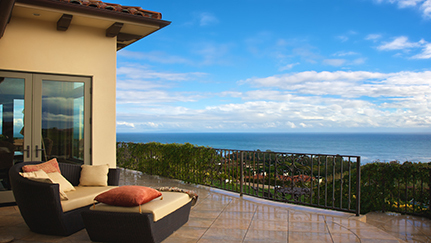Protecting yourself when the coast calls

Protecting yourself when the coast calls
Many people are lured to the Atlantic and Gulf coasts for the ocean breezes, sweeping vistas and the laid-back lifestyle having a home by the water provides. However, it's important that they consider another less desirable part of dwelling by the seaside: the risk of hurricanes.
Today, experts have satellite imagery and computer models to help them predict when and where hurricanes will land. However, each storm is different, and even with advances in technology and seasoned professionals monitoring their progress, the movement of hurricanes, tropical storms and tropical depressions can be difficult to predict.
The dangers these storms can bring is undeniable. Storm surges, high winds and heavy rainfall can cause tremendous damage and flooding both along the coast and inland. The churning sea can cause perilous rip currents, too. On top of that, the thunderstorms, winds and warm air can spawn yet another danger — tornadoes.
For those who long for oceanside living, it's important to appreciate the potential hazards and consider the proactive measures they can take to protect themselves.
Understanding the risk
According to the National Oceanic and Atmospheric Administration (NOAA), the 2020 Atlantic hurricane season ended with a record-breaking 30 named storms, which includes 11 storms that made landfall in the continental United States.1 This hard-hitting season is not an anomaly, unfortunately. NOAA reports that 18 of the past 26 hurricane seasons have brought above-normal activity.
The damage has been devastating in some areas. According to the International Insurance Institute, 47 people lost their lives in the U.S. due to hurricanes in 2020,2 most of whom perished in Hurricane Laura, a category 4 storm that made landfall in Louisiana. Millions of homes and businesses were also affected.
Damage like this come with a big price tag. Swiss Re reports that natural disasters, including Atlantic hurricanes, resulted in the loss of $76 billion by insureds in 2020.3 Many insurers were not able to absorb the losses and became insolvent, leaving insureds with fewer options for protection.
“A number of insurers experienced devastating losses during recent hurricane seasons,” said Amber Stobel, Personal Lines Underwriting Insights Director. “While that's bad for insurers, it's even worse for homeowners who are vulnerable because of where they live and who need the protection that insurance provides.”
Mitigating the impact of coastal catastrophes
Fortunately, there are many steps homeowners in hurricane zones can take to help protect themselves from high winds and other storm-related damage—starting on the outside.
First, the roof is an essential part of the defense of a structure. Keeping it well-maintained by repairing loose or missing shingles will help protect the inside of the home. Installing roof strappings will further secure the roof against high winds by anchoring it to the walls, according to FEMA.4 Seal cracks and gaps around doors and windows to prevent water from getting inside, too.
A lot of damage occurs when winds pick up loose objects, such as outdoor furniture, fences and sheds, and they become projectiles. To reduce the risk of this kind of damage, secure outdoor items properly. You can even secure the foundation of your home to the ground using anchor bolts. Also, keep trees trimmed, and plant them a full tree height away from any structure on your property.
Inside, you're best protected when you have taken measures to secure your windows and doors, which can fail as a result of the pressure created by high winds. Install storm shutters on windows and glass doors, and use stormproof, high-impact glass to provide another layer of protection. Don't forget to reinforce garage doors, too, with heavy-duty deadbolts to keep them in place.
“Every chance I get, I tell my agents to advise the insureds to install wind protection devices in order to protect their homes,” says Ananka P. Willocks, Senior Personal Lines Account Executive, Hull & Company.
It's also a good idea to seek the advice of a professional to help identify—or build—a safe room where you can seek shelter during a hurricane.
Protecting yourself with the right policy
Finally, for those living in hurricane-prone areas, it's essential to secure the right insurance coverage. Insureds should take time to check their homeowners or mobile home insurance policy and verify that they have sufficient storm-related coverage.
“I always advise the agent to stress the importance to the insureds of properly insuring their homes with the best coverage available, such as replacement cost, in order to mitigate the out-of-pocket expenses in the event of a loss,” says Willocks.
“Some homeowners opt to carry a higher deductible for wind coverage so they can pay lower premiums,” adds Stobel. “They should talk to their insurance professional about the best options for their unique situation.”
In the event of hurricane damage, it's important for insureds to have a list of their belongings, which will help speed up the claims process. They can also document high-value items by taking photos or videos of them. It's important to store this information somewhere safe, such as in the cloud, so it's accessible even if the home is damaged.
How Nationwide is protecting insureds
When residents of coastal areas have the right precautions in place and the appropriate insurance policy in effect, they can enjoy the peace of mind that comes with being prepared for whatever may come their way.